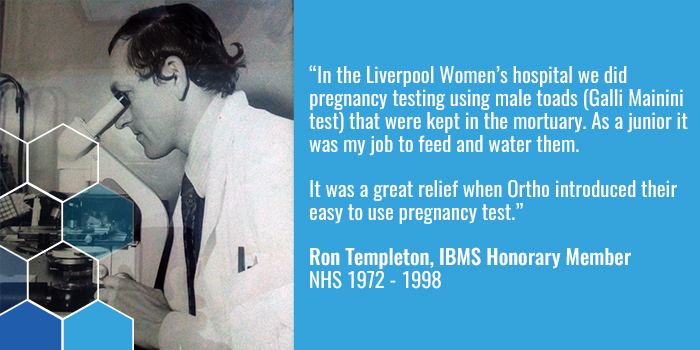Ron Templeton

Ron Templeton joined the NHS at age 19. In his own words, here is his story about his career working in the NHS.
Beginnings
I was born in 1940. I commenced working for the NHS and began my lab career in 1959 at the Royal Liverpool Children's Hospital Myrtle St. This laboratory was part of the so-called Children's group which consisted in addition, Women's Hospital and Oxford Street Maternity.
Life in the laboratory – mercury and toads
In those days we had to make our own swabs, re-use glass slides, cover slips and test tubes.
I remember the lab cleaner saying to me, “That if we didn't put the jelly in the glass Petri dishes it would be easier to clean.”
The floor standing autoclave was in the bacteriology lab which enabled us to make certain culture media, the meat obtained from the local abattoir.
The laboratory was not too mechanised or automated, as the Coulter was in its infancy.
In haematology the blood had to be collected by using a Sahli pipette attached to a rubber tubing and a mouth piece and the cells counted in a Fuchs Rosenthal counting chamber, and slides stained on a rack in the sink. We did coagulation by Ivy and Duke's method.
Blood was X matched from large glass bottles delivered from the local BTS, the same place you went to for your night classes. Biochemistry was more automated and I can remember using the Van Slyke and scrapping up the spilt mercury by hand. There was little quality control then.
Bacteriology was primitive. Urine protein was tested by boiling with acetic acid, sugar with Benedict and microscopy for cells and casts on re-usable glass slides. Most media was bought in granular form from ovoid and made up on the open bench.
Histology was interesting, staining by hand, knife sharpening by stropping. In the Liverpool Women's hospital we did the pregnancy testing using male toads (Galli Mainini test) and as a junior it was my job to feed and water them. They were kept in the mortuary. It was a great relief when Ortho introduced their easy to use pregnancy test.
Achievements and the swinging sixties
I was fortunate to be involved with pioneering “hole in the heart “operations and at the Maternity hospital were ant D was discovered by Finn and Clarke.
For your final practicals you were sent to another city, many brought their own microscopes and even microtomes.
Because the hospitals and the labs were smaller we had a closer relationship with the rest of the medical profession, even teaching medical students.
I enjoyed my time working for the NHS in those days going through, Zukerman, Howie and Cogwheel. I discovered the seventh Hairy cell leukaemia in the world and possibly an early diagnosis of toxic shock syndrome.
The hospital was part of the United Liverpool Hospitals and as a keen sportsman I played tennis and badminton and football for them. My social life was great in Liverpool in the swinging sixties, going to mess parties and concerts.
I am glad I worked in the NHS at that time. I am a great believer in the NHS.
Ronald Templeton FIBMS
